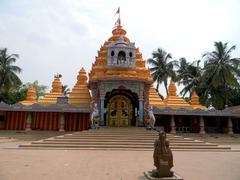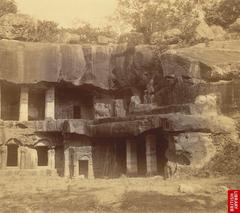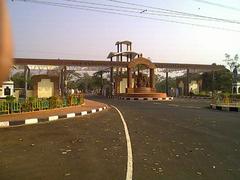Gangesvara Siva Temple Visiting Hours, Tickets, and Bhubaneswar Historical Sites Guide
Date: 04/07/2025
Introduction
The Gangesvara Siva Temple, nestled in Bhubaneswar’s Old Town precinct—the heart of Odisha’s “Temple City”—stands as an enduring symbol of spiritual devotion and architectural brilliance. Dedicated to Lord Shiva and rooted in the Eastern Ganga dynasty era, the temple exemplifies the mature Kalinga architectural style. Its proximity to revered sanctuaries like Lingaraj and Lakhesvara temples and its prominence in pilgrimage circuits underscore its significance within Bhubaneswar’s sacred geography (TravelTriangle; Tripcrafters).
This guide provides a thorough overview of the temple’s history, architecture, religious significance, practical visitor information (including visiting hours and accessibility), travel tips, and nearby attractions. Whether you are a devotee, history enthusiast, or cultural traveler, this guide will equip you to appreciate the heritage encapsulated in the Gangesvara Siva Temple and its surroundings.
Origins and Location
Situated at latitude 20°14’27” N and longitude 85°50’12” E, and standing at an elevation of 73 feet, the Gangesvara Siva Temple occupies the Old Town area of Bhubaneswar, Odisha. It is positioned just 200 meters northeast of the Lingaraj Temple and 50 meters north of Lakhesvara Temple, highlighting its centrality in Bhubaneswar’s spiritual landscape (TravelTriangle).
Historical and Architectural Overview
Historical Background
The temple dates back to the 11th–15th centuries, during the Eastern Ganga dynasty, a period when Shaivism was at its zenith in Odisha. Built primarily in the Kalinga style, the temple features a rekha deula (curvilinear spire), intricate stone carvings, and subsidiary shrines, though it is more modest compared to the nearby Lingaraj Temple (Travelsnwrite). Over time, the temple has seen renovations, with reused stones and sculptures from various eras, reflecting its continuous reverence and evolving architectural narrative.
Mythological Significance
Legend holds that after Goddess Parvati vanquished demons in Ekamra Kshetra, Lord Shiva struck the earth with his trident to create a sacred spring, summoning river goddesses Ganga and Yamuna to purify the land. This myth, echoed in the temple’s name and the adjacent Yamunesvara shrine, reinforces its associations with purification and renewal (Wikipedia).
Religious and Cultural Importance
Ritual Practices and Festivals
The Gangesvara Siva Temple is a vibrant center for daily worship, with rituals such as abhisheka (bathing the Shiva lingam) and floral offerings. The temple hosts major festivals including Maha Shivaratri, Chandana Yatra, and Kartika Purnima—occasions that attract large congregations and feature elaborate rituals (Vajiram & Ravi). The celebration of diverse festivals showcases Odisha’s inclusive religious culture (History Discussion).
Community and Artistic Influence
As a cultural hub, the temple supports classical dance and music events, particularly those inspired by Shiva-centric themes, and serves as a space for religious discourses and community gatherings (Pathbeat). Its artistic legacy is evident in the intricate sculptures and motifs that adorn its walls, influencing Odissi dance and local craftsmanship.
Practical Visitor Information
Visiting Hours and Entry
- Hours: Open daily from 6:00 AM to 8:00 PM.
- Entry Fee: Free for all visitors; donations are welcome.
Accessibility
The temple is accessible via gently sloped pathways, though some areas may have uneven flooring due to their antiquity. Assistance can be requested from temple staff.
Dress Code and Etiquette
Visitors should dress modestly—long trousers or dhotis for men, sarees or salwar kameez for women. Footwear must be removed before entry. Maintain silence and set mobile devices to silent mode. Photography is permitted in the outer precincts but restricted inside the sanctum (Styles at Life).
Facilities
Basic amenities such as drinking water and restrooms are available nearby. Shoe racks are provided at the entrance. Vendors offer flowers and offerings, and priests are available to assist with rituals (GoSahin).
How to Reach
Bhubaneswar is well-connected by air, rail, and road. The temple is approximately 5 km from Bhubaneswar Railway Station and 4 km from Biju Patnaik International Airport. Auto-rickshaws, cycle rickshaws, and app-based taxis offer easy access to the Old Town area (Native Planet).
Best Time to Visit
The ideal time to visit is from October to February, when the weather is pleasant. Festival periods are culturally rich but more crowded. Early mornings and evenings offer a serene temple atmosphere.
Navigating the Temple Complex
The temple’s layout includes the vimana (sanctum tower), jagamohana (assembly hall), and subsidiary shrines. Observe the detailed carvings and iconography that narrate stories from Hindu mythology (GoSahin).
Architectural Highlights
- Vimana: Curvilinear rekha deula rising above the sanctum.
- Jagamohana: Assembly hall with pyramidal roof and carved pillars.
- Material: Locally sourced sandstone, assembled with mortise and tenon joints, ensuring durability (YugIAS).
- Sculptures: Divine figures, mythological scenes, apsaras, and decorative motifs.
- Engineering: Use of iron beams for structural stability (Tourism Orissa).
Accessibility for Differently-Abled Visitors
While ramps are limited and some pathways are uneven, assistance and planning can make the visit manageable for those with mobility challenges.
Nearby Attractions
- Lingaraj Temple: Bhubaneswar’s most prominent temple, 200 meters away.
- Mukteshvara Temple: Renowned for its exquisite arched gateway.
- Rajarani Temple: Distinct for its reddish sandstone and sculptural art.
- Bindusagar Lake: Sacred water body with religious significance.
- Ekamravan: Medicinal plant garden linked to temple mythology (Asia361; Oyo Rooms).
Safety and Responsible Tourism
- Keep valuables secure.
- Use official donation counters.
- Avoid touching idols and entering restricted areas.
- Dispose of waste responsibly.
Language and Communication
Odia is the primary language, with Hindi and English widely understood. Priests and staff can often communicate in basic English.
Food and Refreshments
No eateries are located within the temple complex, but the nearby Old Town offers local cuisine and street food. Prasad (blessed food) is distributed during festivals (WanderOn).
Frequently Asked Questions (FAQs)
Q: What are the visiting hours?
A: 6:00 AM to 8:00 PM daily.
Q: Is there an entry fee?
A: No, entry is free; donations are welcome.
Q: Is the temple accessible to differently-abled visitors?
A: Accessibility is limited due to steps and uneven paths; assistance may be necessary.
Q: Are guided tours available?
A: Local guides are available near the temple and through Bhubaneswar tourism offices.
Q: Is photography allowed?
A: Permitted in outer precincts, restricted in the sanctum.
Q: What is the best time to visit?
A: October to February for pleasant weather.
Tips for a Memorable Visit
- Visit early for a tranquil experience.
- Dress conservatively and remove footwear at the entrance.
- Observe rituals respectfully and maintain silence.
- Carry essentials like water and sun protection.
- Explore nearby temples and markets for a holistic Bhubaneswar experience.
Conclusion
The Gangesvara Siva Temple is a timeless beacon of Odisha’s religious, architectural, and cultural heritage. Its architectural marvels, mythological associations, and vibrant rituals offer a profound experience for every visitor. By observing visiting hours, respecting customs, and exploring nearby attractions, you can immerse yourself in the spiritual and historical fabric of Bhubaneswar.
For further details, download the Audiala app and explore our related posts for comprehensive travel guides and updates on Odisha’s temple heritage.
Sources and Official Links for Further Information
- TravelTriangle
- Tripcrafters
- History Discussion
- Vajiram & Ravi
- Wikipedia
- Stamped Moments
- Pathbeat
- Tourism Orissa
- YugIAS
- Ease India Trip
- Native Planet
- GoSahin
- Travelsnwrite
- Styles at Life
- Asia361
- Oyo Rooms
- WanderOn








